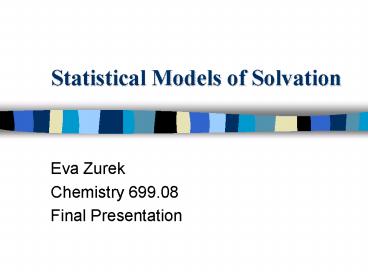Statistical Models of Solvation - PowerPoint PPT Presentation
1 / 16
Title:
Statistical Models of Solvation
Description:
For BBL water b0(rsw) = 0, giving the HNC-OZ. ... Problems: which solvent model? which closure? how to calculate and ? Thanks: Dr. Paul ... – PowerPoint PPT presentation
Number of Views:45
Avg rating:3.0/5.0
Title: Statistical Models of Solvation
1
Statistical Models of Solvation
- Eva Zurek
- Chemistry 699.08
- Final Presentation
2
Methods
- Continuum models macroscopic treatment of the
solvent inability to describe local
solute-solvent interaction ambiguity in
definition of the cavity - Monte Carlo (MC) or Molecular Dynamics (MD)
Methods computationally expensive - Statistical Mechanical Integral Equation
Theories give results comparable to MD or MC
simulations computational speedup on the order
of 102
3
Statistical Mechanics of Fluids
- A classical, isotropic, one-component, monoatomic
fluid. - A closed system, for which N, V and T are
constant (the Canonical Ensemble). Each particle
i has a potential energy Ui. - The probability of locating particle 1 at dr1,
etc. is - The probability that 1 is at dr1 and n is at
drn irrespective of the configuration of the
other particles is - The probability that any particle is at dr1 and
n is at drn irrespective of the configuration of
the other particles is
4
Radial Distribution Function
- If the distances between n particles increase the
correlation between the particles decreases. - In the limit of ri-rj?? the n-particle
probability density can be factorized into the
product of single-particle probability densities. - If this is not the case then
- In particular g(2)(r1,r2) is important since it
can be measured via neutron or X-ray diffraction - g(2)(r1,r2) g(r12) g(r)
5
Radial Distribution Function
- g(r12) g(r) is known as the radial distribution
function - it is the factor which multiplies the bulk
density to give the local density around a
particle - If the medium is isotropic then 4pr2rg(r)dr is
the number of particles between r and rdr around
the central particle
6
Correlation Functions
- Pair Correlation Function, h(r12), is a measure
of the total influence particle 1 has on particle
2 - h(r12) g(r12) - 1
- Direct Correlation Function, c(r12), arises from
the direct interactions between particle 1 and
particle 2
7
Ornstein-Zernike (OZ) Equation
- In 1914 Ornstein and Zernike proposed a division
of h(r12) into a direct and indirect part. - The former is c(r12), direct two-body
interactions. - The latter arises from interactions between
particle 1 and a third particle which then
interacts with particle 2 directly or indirectly
via collisions with other particles. Averaged
over all the positions of particle 3 and weighted
by the density.
8
Closure Equations
9
Thermodynamic Functions from g(r)
- If you assume that the particles are acting
through central pair forces (the total potential
energy of the system is pairwise additive),
, then you can calculate
pressure, chemical potential, energy, etc. of the
system. - For an isotropic fluid
10
Molecular Liquids
- Complications due to molecular vibrations
ignored. - The position and orientation of a rigid molecule
i are defined by six coordinates, the center of
mass coordinate ri and the Euler angles - For a linear and non-linear molecule the OZ
equation becomes the following, respectively
11
Integral Equation Theory for Macromolecules
- If s denotes solute and w denotes water than the
OZ equation can be combined with a closure to
give - This is divided into a W dependent and
independent part
12
More Approximations
- is obtained via using a radial
distribution function obtained from MC simulation
which uses a spherically-averaged potential. - is used to calculate b0(rsw) for
SSD water. - For BBL water b0(rsw) 0, giving the HNC-OZ.
- The orientation of water around a cation or anion
can be described as a dipole in a dielectric
continuum with a dielectric constant close to the
bulk value. Thus,
13
The Water Models
- BBL Water
- Water is a hard sphere, with a point dipole m
1.85 D. - SSD Water
- Water is a Lennard-Jones soft-sphere, with a
point dipole m 2.35 D. Sticky potential is
modified to be compatible with soft-sphere.
14
Results for SSD Water
- Position of the first peak, excellent agreement.
- Coordination number, excellent agreement except
for anions which differ 13-16 from MC
simulation. - Solute-water interaction energy for water differs
between 9-14 and for ions/ion-pairs 1-24.
Greatest for Cl-.
15
Results for BBL Water
Radial distribution function around five molecule
cluster of water from theory (line) and MC
simulation (circles)
Twenty-five molecule cluster of water
16
Conclusions
- Solvation models based upon the Ornstein-Zernike
equation could be used to give results comparable
to MC or MD calculations with significant
computational speed-up. - Problems
- which solvent model?
- which closure?
- how to calculate and
? - Thanks
- Dr. Paul

